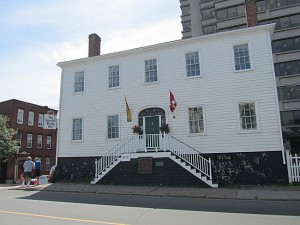
In 1783 the Treaty of Paris ended the American Revolution and thousands of Loyalists fled New England to establish a new life in Europe, England and other parts of British North America. What is today the Village of Weymouth in Nova Scotia was one of the many coastal communities to see a large increase its population following the end of this war.
Weymouth’s most famous Loyalist settler was Lieutenant James Moody. During the American Revolution, Moody risked his life recruiting, gathering intelligence and freeing prisoners from behind enemy lines and was even referred to as “that villain Moody” by George Washington.
James Moody is considered to be one of Weymouth’s founding fathers. Following his arrival in 1786, Moody built a shipyard, donated land for an Anglican church and helped local Acadians receive clear titles to their land. A former farmer, Moody is remembered as one of the greatest Loyalist leaders.
Following the American Revolution, it is also estimated that 5000 former slaves, newly freed slaves and slaves of white Loyalists said good-bye to New England and set off in search of a better life. Seventy percent of these people landed on the shores of Nova Scotia in four separate communities, one of course being Weymouth. Unfortunately, unlike the white Loyalists, these settlers were provided with few opportunities, leaving many no other choice but to return to a life of semi-slavery.
Loyalists in Saint John, New Brunswick
Across the Bay of Fundy in New Brunswick, the city of Saint John also boasts its great Loyalist heritage.
Immediately following the end of the American Revolution, 3000 Loyalists arrived in Saint John, followed by an additional 11,000 before the end of the year, establishing two settlements: Parr Town and Carleton (City of Saint John, 2005). Today visitors to Saint John can retrace the steps of the city’s founders by following the Loyalist Trail, which includes a visit to the spot where the first Loyalists arrived in May of 1783, Loyalist House museum and the Old Loyalist Burial Ground in the centre of the city.

Built in 1810, the Georgian-style “Loyalist House” is the oldest building in the City of Saint John. Built by a wealthy Loyalist from New York, David Daniel Merrit, six generations of Merrit’s went on to call this Union Street dwelling “home”. Loyalist House contains many impressive features such as eight fireplaces, authentic Georgian antique furnishings and a graceful curving staircase.
The Loyalist Burial Ground was established after the landing of the United Empire Loyalists and was closed as a cemetery in 1848. Today it is a memorial garden with tree-lined pathways and beautiful flowerbeds. Throughout the grounds find statues of the Canadian beaver, depicting the “hard work, enterprise and tenacious resolve of the city’s founders and those who followed”. Located in the centre of the city, many use the Old Loyalist Burial Ground as a beautiful spot to sit and reflect on the city’s heritage.
This article is part of our “52 Reasons” series. So check out the next reason: Slow Pace of Life, or last week’s reason: Rockhounding. We also encourage you to take a look at the overview of all the articles in this series and to use our RSS feed so you won’t miss any further articles!
Brian McConnell, UE
Nice article ! Almost all of Digby County, Nova Scotia was settled by Loyalists. It was named after Admiral Digby who brought the Loyalists to Digby from New York after the American Revolution. For more information please see website of Nova Scotia Branch of United Empire Loyalists’ Association of Canada at http://www.uelac.org/NovaScotia/
Regards,
Brian McConnell, UE
President
Nova Scotia Branch
United Empire Loyalists’ Association
of Canada